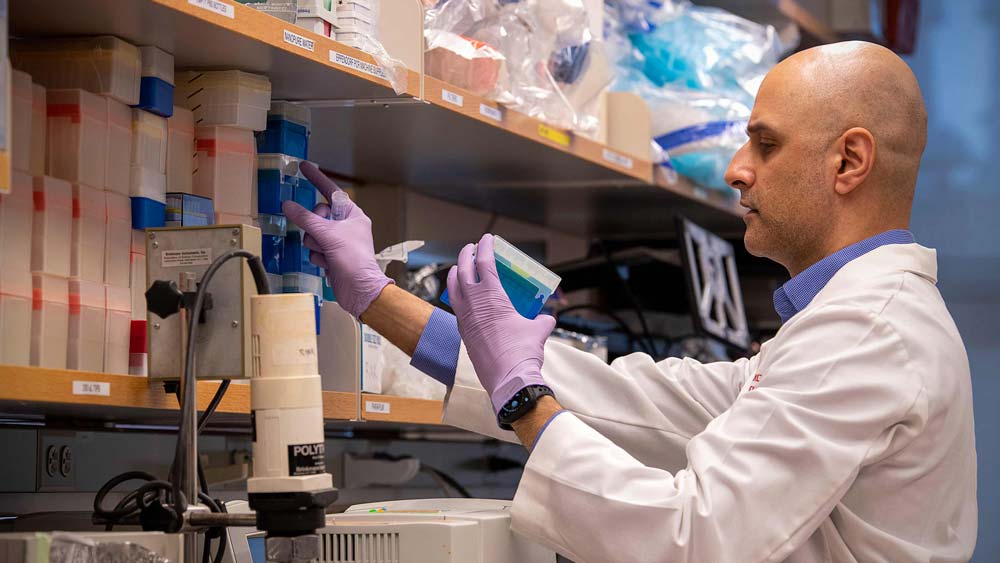While getting to the hospital quickly is important if you’re experiencing stroke symptoms, you also want the best — and fastest — team responding to your needs once you arrive there.
The Ohio State University Wexner Medical Center is the only hospital in central Ohio that can provide immediate bedside care around the clock by a stroke neurologist. This attention speeds the treatment process and provides the best possible opportunity to save brain tissue and prevent permanent damage.
But because strokes can leave lasting impacts, you also want excellent care after your stroke is stabilized. Specialists with the Ohio State Wexner Medical Center stroke rehabilitation program are uniquely trained to help you in that journey in the weeks and months following a stroke.
Where you go for treatment for a stroke matters. Whether you need us for a quick diagnosis, an advanced surgical technique or an individualized, evidence-based rehab plan, you’ll be in good hands at Ohio State during your stroke recovery.
Stroke treatment
Our entire stroke team — which includes stroke neurologists, specialty-trained nurse practitioners, physicians and neurosurgeons, imaging specialists and technicians and nurses — will be available as soon as you come through the doors at Ohio State. They will follow you throughout the treatment process from admission to discharge from the hospital.
With state-of-the-art imaging technology, our team will determine exactly what kind of stroke you’re experiencing and where it is in the brain. From there, we’ll begin treatment or prep you for surgery.
Treatment for an ischemic stroke
With an ischemic stroke, which is caused by a blockage, blood flow must be restored quickly to the brain. This is done with a clot-busting drug given through an IV.
The sooner this is done, the better chance for positive outcomes. If you aren't able to use medications and the blockage is in one of the main blood vessels of your brain, neurosurgeons can perform either or both of the following procedures:
- Thrombectomy, in which we insert a catheter into your groin and thread it to the area of the clot. The catheter is equipped with either a suction device or a mechanical device to remove the blood clot from your artery.
- Intra-arterial thrombolysis, in which we insert a catheter and thread it to the tiny arteries in your brain. We inject medicine through the catheter to dissolve the blood clot.
Treatment for a hemorrhagic stroke
With a hemorrhagic stroke, our goal is to stop bleeding into the brain, whether through medications or surgery and to control blood pressure.
In some instances, stroke can be treated with medications alone. Our Neuro Critical Care Unit team has the expertise to manage, with medicines, subtle changes in blood pressure and swelling in the brain, controlling the stroke.
If you do need further treatment, such as surgery, our dual-trained neurosurgeons can perform a number of lifesaving procedures, both minimally invasive radiological interventions and traditional surgeries.
Your surgical options for hemorrhagic stroke will also depend on what type your having, whether a subarachnoid hemorrhage caused by an aneurysm rupture or an intracerebral hemorrhage caused by a ruptured blood vessel.
Surgeries for hemorrhagic strokes include:
- Aneurysm embolization: In this minimally invasive procedure, our neurosurgeons insert a tube, or catheter, into an artery in the groin. The surgeon threads the tube to the site of the aneurysm and can fill the aneurysm with tiny coils, a web device or pipeline stent device. All these devices block blood from entering the aneurysm. Our surgeons were the first in Ohio to offer a pipeline stent to patients.
- Aneurysm clipping: Our neurosurgeons can clip the aneurysm (balloon-like bulge in an artery) to block it off from blood vessels in the brain to prevent further leaking.
- Arteriovenous malformation repair: Our surgeons open the skull to stop bleeding and to drain off extra spinal fluid that could cause the brain to swell.
What happens after my stroke is treated?
At the Ohio State Wexner Medical Center, stroke treatment doesn’t end after the emergency department, ICU or even discharge. We’re a leader in developing and administering the most current therapeutic options to help you regain functions and return to independent living.
Since stroke affects all people differently, experts in our stroke rehabilitation program take an individualized approach with each patient. Depending on your specific needs, you might work with physical and occupational therapists, speech pathologists or psychiatrists, along with doctors and nurses.
We want to see you back on your feet and back to living your life as soon as possible.
What happens if I have a stroke and don’t live near Ohio State or a hospital that treats stroke?
People in other parts of the state still have access to the experts and cutting-edge technology that the stroke center at Ohio State Wexner Medical Center has to offer.
We have established the life-saving Telestroke Network, which includes 27 hospitals in rural areas. If you’re taken to one of those emergency departments with stroke symptoms, experts would be mobilized both there and at Ohio State Wexner Medical Center through a stroke alert.
Then, video technology is used to link you directly with stroke specialists at Ohio State to assist in decision making about your treatment. We’ll interview you, view test results and vital signs and if necessary, prescribe clot-busting medications within minutes.
Should you require surgery or a more advanced level of care, such as some of the treatments outlined above, a transfer to Ohio State’s Comprehensive Stroke Center is arranged.
Watch Eva's story of stroke treatment and recovery at Ohio State
Read about a promising new stroke treatment developed at Ohio State

A promising new drug therapy developed by the Ohio State Wexner Medical Center neurosurgeon Shahid Nimjee, MD, PhD, may hold the key to providing effective treatment to stroke victims and solving one of the biggest complications in strokes: bleeding.

